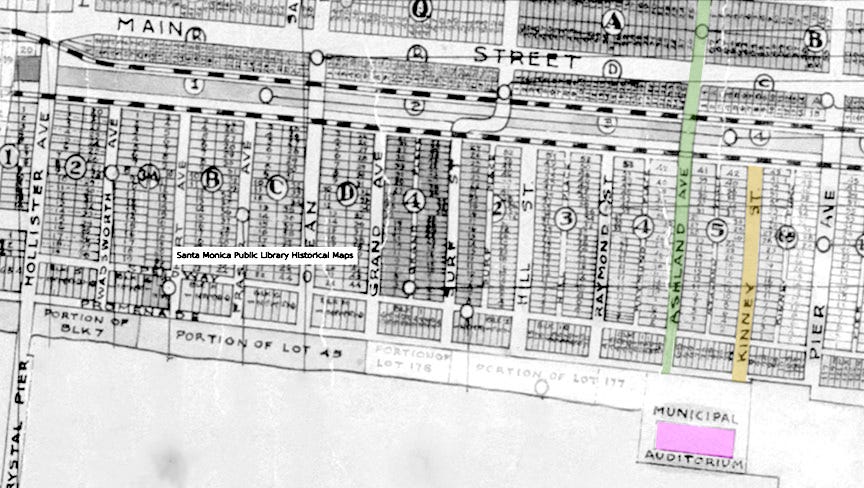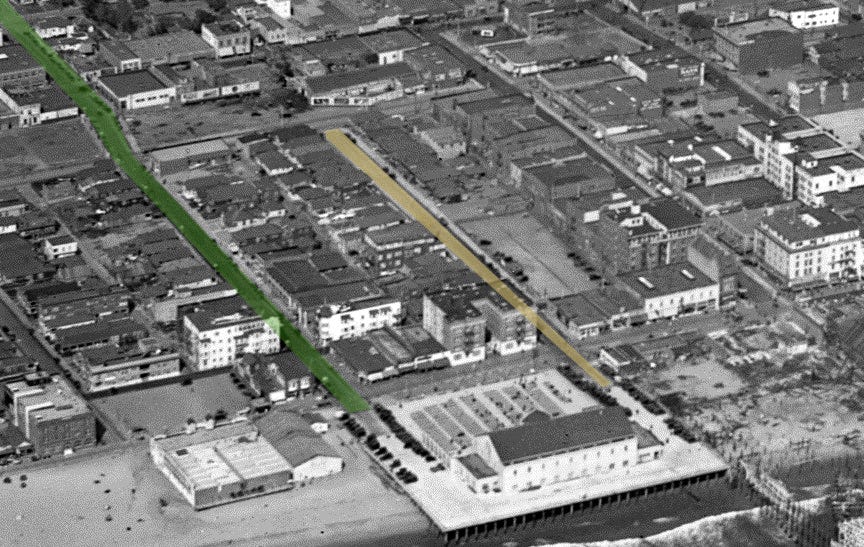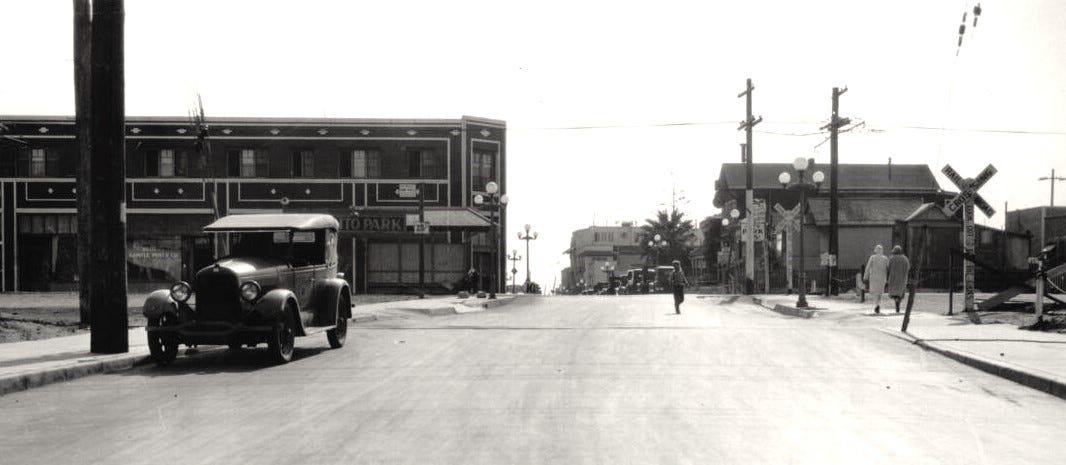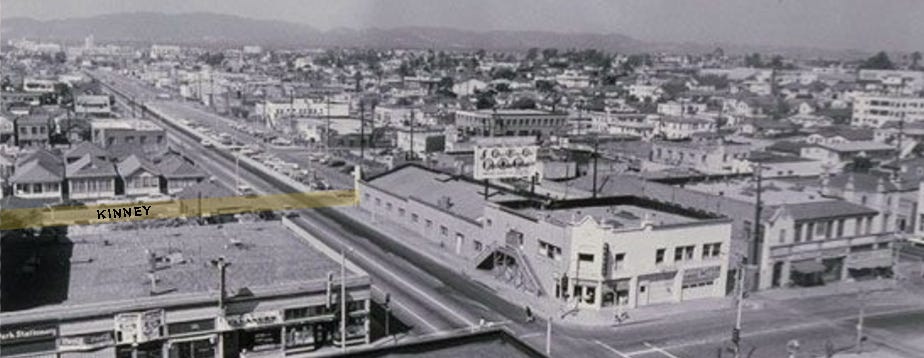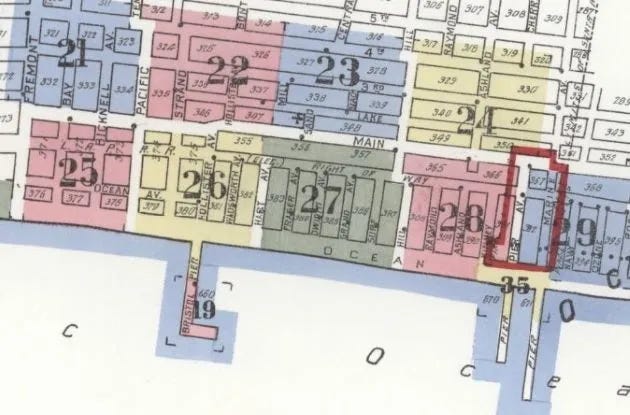In 1932, after years of discussion, Kinney Street is extended east across Neilson through to Main St.
By the early 1900s, the Ocean Park entertainment zone, centered on Pier Ave, is a major tourist attraction.
By the early 1920s, with the increasing automobile use, the zone suffers from traffic congestion and a lack of parking. The only north-south vehicular access is Speedway - a narrow 20 ft wide alley. Between Hollister Ave and Pier Ave, many of the east-west streets of the Kinney & Ryan tract dead end at Neilson.1
Kinney St2 is a residential street just north of Pier Ave. Although Kinney dead ends at Neilson, there are discussions in 1920 about making the 50 ft wide street a commercial street.
In 1921, the Municipal Auditorium, extending along Ocean Front between Ashland and Kinney, opens with an over-water parking pier. However, the Municipal Auditorium can only be accessed from the rest of Ocean Park via Ashland Ave.
The main (only ?) obstacle to connecting the east-west dead-end streets to Main St and the rest of Ocean Park, is the crossing of the Pacific Electric Railway right of way that extends along Neilson.3 A four-car train on the Pacific Electric tracks stopping for automobile traffic at Kinney St would block Pier Ave.
In 1926, the widening of Main Street (and the contemporaneous extension of Pier Ave across Main St to 2nd St) goes ahead - without the Kinney St extension.4
The traffic problems get worse. On a summer weekend, thousands of autos can’t get to the Ocean Park entertainment zone. Business suffers, and attendance at the Municipal Auditorium declines. Finally, in 1928, the Los Angeles County Grade Crossing Committee5 announces that it ‘won’t oppose’ the extension of Kinney St across the Pacific Electric tracks to Main St. Having now obtained implicit Railroad Commission approval, the City moves to implement the Kinney St extension. Ocean Park is thrilled “OP Expects Early Opening of Kinney St” - Evening Vanguard, June 1, 1928.
In 1929, a special assessment (tax) district to pay for the Kinney extension is defined.6 Condemnation proceedings in Los Angeles Superior Court take place in 1930 to acquire the property located in the path of the Kinney St extension.7 To pay for the acquisition of this property, the City in 1931 issues $35,000 in bonds. In the midst of the Depression, the City has trouble selling the bonds,8 but five months later, the bonds are sold, and the Main St properties acquired in late 1931. The opening of Kinney St is now expected in early 1932.9
Engineering plans for the Kinney St extension are completed in February 1932.10 In June 1932, the City adopts Special Ordinance No. 621 setting forth the scope and authorizing the work. Construction begins at the end of August 1932.11 In September 1932, the north end of an existing 1926 building12 that would extend into the new Kinney St is demolished, and a new decorative front on Kinney is added to the building.
In October 1932, the Kinney St work is close to completion, when the Railroad Commission advises that the new street cannot be used until illuminated stop signs on both approaches to the Pacific Electric tracks are installed.13 The stop signs are ordered.
The Kinney St extension opens without fanfare in late 1932.

After years of heavy use, the Pacific Electric streetcar along Neilson begins losing popularity.14 Streetcar service is reduced in 1933, and in 1940, the line is abandoned entirely.
In 1965, as part of the Ocean Park Redevelopment Project, everything (except the Marine St Telephone Exchange building) west of Neilson between Ocean Park Blvd and the south city border is demolished.
All of the Ocean Park entertainment zone streets are gone.15 The only piece of Kinney St that is left is the 1932 extension between Neilson and Main St.
The general configuration of Ocean Park streets derives from the 1875 Lucas Ranch and 1891 Kinney & Ryan tracts. These two tracts are independently subdivided - without coordination or an overall plan. The Lucas (the hills east of Main St) and Kinney (along the ocean) tracts abut parallel to and just south of Main St.
At the time of the tract subdivisions, Ocean Park is a small beach resort. Little consideration is given to automobiles. The streets are narrow and often have dead ends or detours.
Kinney St is named for Abbot Kinney (1850 – 1920) - the visionary developer who turns Ocean Park into a beach resort before creating “Venice of America.”
The trolley right-of-way is private property and so does not have an official name. To avoid confusion, beginning in 1905, the thoroughfare is called Trolley Way. In the late 1930s, the Pacific Electric right-of-way is converted to street use. The name is changed to Neilson Way in 1954, in honor of City Council member George A Neilson (1890 – 1954).
Craigs Market (2924 Main St - see photo below), in the middle of the block between Ashland and Pier in 1928, will eventually end up being on the SWC Main & Kinney.
The Railroad Commission (now the California Public Utilities Commission) regulates rail grade crossings with advice from Grade Crossing Committees in each county. The Los Angeles County Grade Crossing Committee is composed of representatives of the State, County, Cities, and the Automobile Club of Southern California.
Main St property owners in the Kinney assessment district, already paying the Main St widening tax, are not happy about additional tax to pay for the Kinney St bonds. They become more unhappy – they are paying assessments, yet the actual work is delayed until the end of 1932.
The City bonds cannot be sold at a discount – they must be sold at least at par. The owners of the Main St property to be acquired will not accept bonds in lieu of cash. Since May 1931, the $35,000 bonds lie unsold in the Santa Monica city treasury, but having accumulated $4,000 in interest, they are sold in October 1931 to Los Angeles municipal bond firm G. Brashears & Co.
In 1932, residents on Kinney St petition the City to have street parking prohibited on Kinney.
The extension of Kinney is expected to cost $4,900 of which half is levied against Pacific Electric. Pacific Electric appeals its assessment to the City – claiming to be exempt by state law from local assessments.
In 1915, an office and automobile parking garage is built on the NEC Pier and Neilson. In 1926, to accommodate the widening of Main St, Pacific Electric replaces the building with a 60 ft x 200 ft building.
The north end of the 1926 Pacific Electric parking garage would extend into the new Kinney Street. In September 1932, 10 ft from the north end of the garage is removed – and replaced with a decorative façade and a Kinney St entrance.
In July 1935, Charles W. Van Dusen and his wife suffer critical injuries when their automobile, driven by Charles, is hit by a Pacific Electric train on Kinney at Neilson.
By the 1930s, automobiles become the dominant mode of transportation in Southern California, especially by tourists visiting Santa Monica. Heavy competition by local bus companies offering transportation to and from Santa Monica also plays a major role in the end of the Pacific Electric line, as does the general decline of tourism in the area due to the Depression.





